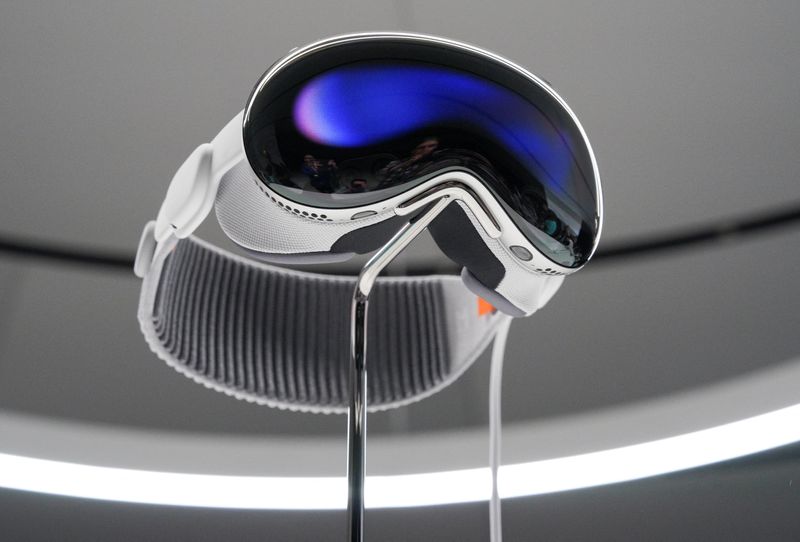What it’s like to try Apple’s new Vision Pro headset
2023.06.05 23:01

© Reuters. Apple’s Vision Pro headset is on display at Apple’s annual Worldwide Developers Conference at the company’s headquarters in Cupertino, California, U.S. June 5, 2023. REUTERS/Loren Elliott
2/4
By Stephen Nellis
CUPERTINO, California (Reuters) – Apple Inc (NASDAQ:) on Monday let analysts and media, including Reuters, try its $3,499 Vision Pro headset.
What is immediately clear is the device is not yet meant for a mass market: a test drive requires a setup session with Apple staff and a quick visit with a vision specialist to ensure the headset fits and functions as intended. And the price tag is likely to keep all but the most dedicated Apple fans and business users away.
Instead of starting with a consumer version and working up to a “Pro” model, Apple is starting with the premium tier and hoping to bring prices down as the technology matures, said Carolina Milanesi, an analyst with Creative Strategies.
Apple released the Vision Pro in an attempt to wrest the nascent headset category away from Meta Platforms Inc (NASDAQ:), which has already released several headsets but struggled to break out of a virtual reality market long dominated by video games.
The Vision Pro headset has a “digital crown” similar to an Apple watch crown, which can be tapped and turned to make the display transition fluidly between the real world outside and the virtual world inside. Walking around a room or viewing a 3D film both feel natural as does watching a virtual butterfly settle on the user’s outstretched hand.
The device also glitched at least once during a demonstration to Reuters, requiring Apple staff to reboot and showing that the iPhone maker still has some kinks to iron out.
Here are some key takeaways from the demonstration:
– The real world and other people are always present. The default mode while wearing the device is to see the outside world in full color. Even when fully immersed in a virtual world, exterior cameras keep an eye out for other humans. If another person approaches the user, that person starts to materialize through the virtual world.
– Hollywood will likely take an interest. Apple demonstrated a series of “immersive videos”, shot on special proprietary cameras where the viewer can step inside and look around.
– The sense of place can be startling. In one video, a tightrope walker suspended between two mountains edges toward the viewer, creating an unsettling urge to look down at an intimidating chasm below. At the same time, the realism can make mundane details look out of place in a polished production, like a cheap plastic water bottle sitting on the piano during a recording session with a famous singer.
– From the outset, Apple has focused on the business case for Vision Pro, demonstrating how to use multiple apps at once in the headset, which is akin to having several high resolution displays. It also showed how two users could share, and manipulate, three-dimensional virtual objects during a conference call. Both are functions that could find some use in the corporate world, where Vision Pro’s price tag would sit on cost centers rather than household budgets.
– Video calls will take some getting used to. Apple showed a FaceTime video call between two people wearing the headset. The experience is similar to a standard video call, but uses complicated technology to project an image of the caller, not a conventional face-pointing handset or monitor camera.
– To construct a virtual “persona” of the caller that shows their facial expressions, the system uses pre-loaded pictures combined with data from the Vision Pro’s interior eye-tracking system and exterior hand-tracking cameras. But the net effect is human-but-not-quite, a phenomenon robotics experts call the “uncanny valley” effect where faces that resemble humans but are slightly off can make users feel uneasy.








